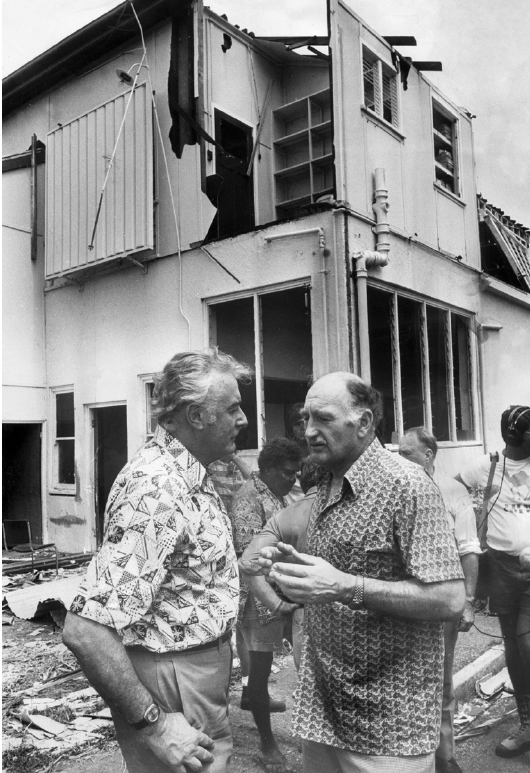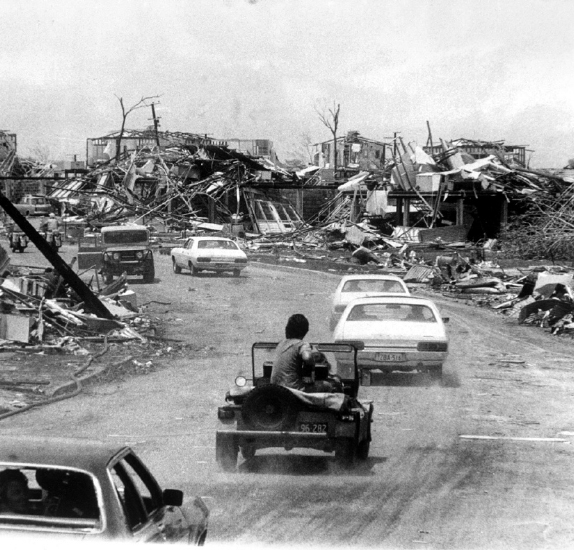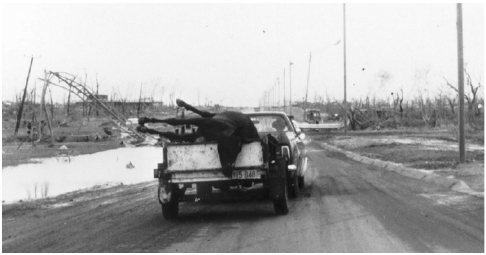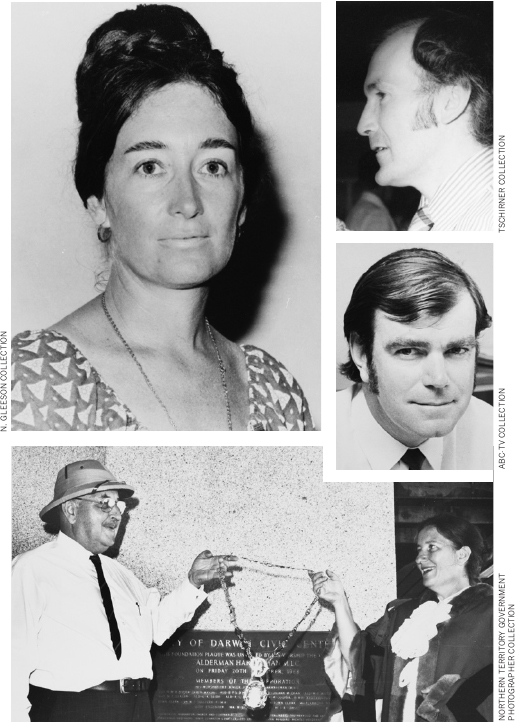Warning (24 page)
Authors: Sophie Cunningham

A lot of relationships that were shaky broke up and things like that. It was a time
for people to reassess everything. I sort of had a change of life, too, I suppose.
I had a change of female companions. The companion I was with went off with a 21-year-old
gambler, funny things like that, you know. It wasn't quite so funny at the time,
but it's quite humorous now.
6
Here's a waltz through police log books
7
at the time which give you a bit of an idea
of what life on the
Patris
was like: a person âdischarged' a firearm on 28 February
causing Constable Snoad to fire a shot. Snoad âwas relieved from duties' and a man
was arrested for disorderly behaviour. On Saturday 1 March police had to contact
a Bob Gillings to let him know his wife was dangerously ill in Brisbane. Later that
day Gillings was reported as drunk and disorderly in the public lounge of the
Patris
and police had to escort him to his cabin. On 3 March they tried to locate a man
(in fact a headmaster) who was living on the ship regarding a five-year-old missing
child who was believed to be camped in his car. On 5 March police boarded to look
for a missing girl, Elly Jones, who was fifteen and was believed to be with her friend
Maria in room 623. âNegative result.' On 8 March a message had to be given to Mr
R. G. Pollen regarding the death of his daughter-in-law. He couldn't be found. That
same day a person was asked to remove their motorcycle from a restricted area but
they refused. On 9 March an anonymous tip-off told police there was a game of two-up
on âMediterranean' deck. âIt appears very likely that a game had been in progress
but no evidence of same on arrival of police.' That same day there was also an incident
in which two police were assaulted, âoutnumbered and withdrew'. They returned with
more police and arrested two of the offenders. Complaints about noise in the lounge
were made later that night. On Saturday 15 March two drunken men accused each other
of assault and someone claimed that the
Patris
staff insulted them. On Sunday 16
March, several card games were reported. On 19 March an ambulance was called because
a woman was ill. On Sunday 23 March police:
received a complaint from a Mr Daltry of cabin no. 335 and a Mr Burns of cabin no.
298. Both men state they are disgusted with the behaviour in general on board the
ship. They said they had their wives and children on board and that they could not
use the lounge areas because of language, drinking and fighting. They further stated
they were going to see their Member of Parliament.
An arrest was made at 9.20 pm that night. The captain, Kandinis, reported trouble
on the gangway. Two men were ordered to be off the ship by noon the next day. On
24 March jewellery was nicked. On 27 March police had to look for the mother of a
baby that was in hospital. She wasn't found. The search for Elly Jones continued
and police were told that she might be found at the house of a man called Ralph.
She was later located at a shopping centre and returned to her mother. That day a
âdeath message' also had to be delivered, in which a man was told his father had
died. On 29 March there were reports of indecent assault. Police attended and spoke
to a woman âWho stated unknown personâ¦caught hold of the lower half of her two-piece
swimmers and pulled them down over her bottom, she stopped the person and left to
seek help.' The man was later located and âclaimed he had had a few beers and it
was only done as a joke.' The woman accepted the apology and didn't press charges
then changed her mind soon after saying âshe had been made a laughing stock of the
ship'. On the same night another man reported that two men had attempted to enter
his daughter's cabin and wouldn't leave. The girl's mother tried to get them to leave
and they still wouldn't go and only left once the father arrived. âPersons believed
to be members of visiting football teams. Unable to locate.' On 9 April a man became
upset about the noise outside his cabin and confronted three Greek teenage girls.
He âobtained no satisfaction'. The brother of one of the girls approached the man,
who punched him in the jaw. No charges were laid. In what is, perhaps, my favourite
entry, a complaint was received on 16 April âfrom a hippy type “gentleman” that Greeks
fishing off wharf had their radio cassette up too loudâ¦advised him that it would
be better to retire to his cabin where he wouldn't be able to hear the noise'.
At this point the suicide attempts began. On 15 April a man took an overdose of tabletsâThiorodazineâand
an ambulance had to be called. His girlfriend confirmed that he was depressed âand
they had been having domestic problems'. On 24 April there were reports that a woman
had overdosed or was about to. Her main complaint was that her children couldn't
sleep at night because of the noise aboard the ship. She was threatening to kill
herself with a mixture of Valium, sleeping pills and Diagesics. When her husband
was contacted he told them she'd had a breakdown. On 29 April another possible overdose
was reportedâthis time it was a young woman.
On 26 April a woman who was four months pregnant collapsed on the dance floor. On
27 April a statement was given regarding a man who was drunk and disorderly, describing
the man as âpissed⦠Abusive and aggressiveâ¦He hates coppers. I don't blame the police
for locking him up. He was in the wrong.' On 8 May a woman reported a man in her
cabin âwho has her key'. On 9 June a man was spoken to about âhitting and intimidating'
an eight-year-old boy who was not his son. On Monday 9 June there was a disturbance
when a man who was estranged from his wife became jealous of her alleged boyfriend.
He also thought his daughter was having a sexual relationship with a crew member.
And on it goes, relentlessly, until the
Patris
left Darwin Harbour on 14 November
1975.
Thirteen of those on the
Patris
were refugees from East Timor, which was in the throes
of the civil war that preceded the Indonesian invasion. Eric Rolls has described
the following scene. After the invasion itself, in early December 1975:
hundreds of frightened women and children got to Darwin in the clothes they stood
up in, by whatever ships they could catchâ¦The women, carrying babies and paper bags,
came ashore to the shouts of wharfies telling them to go home. The atmosphere in
Darwin was harsh; it was rebuildingâ¦
8
This contradicts many people's view that Darwin was, and continues to be, very passionate
about the East Timorese cause and that many Darwinites were extremely welcoming.
Either way, the Timorese had left a nation in ruins, to find a town not doing much
better.
Recovery is a complex process and it takes a long time. The nature of the disaster
will change communities forever: members are lost, services are disrupted, landscapes
are changed, people's sense of safety is compromised. Even resilient communities
can falter if the recovery period takes years. What happens to people is something
akin to war weariness, a condition people in other circumstances have nicknamed âbushfire
brain'. Chemically speaking it's been described as the moment when people run âout
of adrenaline' and move âinto cortisole'.
9
This is one of the reasons it's said that
the third year after a disaster is often the hardest. This is the case whether you've
stayed in the place where disaster struck or whether you've attempted to get on with
your life elsewhere.
But three years? Even getting that far looked like a long haul at the end of 1975.

The PM and the major-general:
Whitlam and Stretton in conversation
JOHN HART / FAIRFAX

Prime Minister Gough Whitlam is
taken on a tour of the wreckage
NEWS LTD / NEWSPIX

Police, armed against stray dogs, check houses in the Casuarina area
RICK STEVENS / FAIRFAX

Dead horse in a trailer being taken out of town along McMillans Road
NORTHERN TERRITORY ARCHIVES SERVICE, BARBARA JAMES, NTRS 1683

Clockwise from top left: Dawn Lawrie, 1977;
Hedley Beare (date unknown); Ray McHenry (date unknown);
Tiger Brennan shares the mayoral regalia with Ella Stack, 1975
ALL PHOTOS THIS PAGE FROM THE NORTHERN TERRITORY LIBRARY
I WASN'T WORRYING ABOUT BLOODY HISTORY.
I WAS WORRYING ABOUT THE DAY
MONEY, AFTER those cashless days and weeks following Tracy, was beginning to dominate
people's lives again: who got it, who deserved it, how it was spent.
In an address to the Melbourne Press Club on 9 November 1976, Major-General Stretton
waxed sentimental for a moment: âFor a few glorious days the nation came together.
We became one country with one purpose. If only we could recapture that unity, keep
that spirit of Darwin going at all times.' Then he went on to express his concern
about the ways in which millions of dollars in relief funds were being spent and
call for a Royal Commission into the Cyclone Tracy Relief Trust Fund. âI do not question
the honesty of the trustees. However I do question the priorities.' Stretton felt
that money should be spent on people, not on rebuilding churches, schools, cultural
centres and the like. His point was that almost half of those evacuated never returned,
âSo the cultural centre is not going to do them much good, is it?'
These days rebuilding such infrastructure would be seen as unequivocally essential
to rebuilding a community after a disaster. But Stretton was not alone in his view
and Ray McHenry expressed similar concerns about the uses the funds were put to.
It's no surprise. These questions arise again and again after all disasters: the
misallocation of funding, changes in land use that favour the rich, and the politics
of exclusion of the poor and ordinary people from policy-making and decision-making.
The Cyclone Tracy Relief Trust Fund had been established at the beginning of 1975,
when the federal cabinet decided that donations and offers of overseas assistance
from the South Pacific, Europe and Africa needed to be formalised. As well, there
were nationwide appeals encouraging Australians to donate money and goods. Minister
Rex Patterson was the chairman of the fund, and its members included Jock Nelson,
Mayor Tiger Brennan, Paul Everingham, Ella Stack and Alec Fong Lim. They received
and distributed more than eight million dollars before being formally wound up in
October 1976. As well as paying for various aspects of the rebuild, the fund gave
out benefits that were allotted with blunt directness: women who had lost their husbands
got a payout of ten thousand dollars, whereas a lost wife was only worth five thousand.
Regardless of the crassness of this kind of assessment, money was obviously extremely
important at this time. While Les Garton remembers that some people tried to rip
off the insurance companies after Tracy, in the great scheme of things this was not
nearly as big a problem for the community as the opposite situation: people being
woefully underinsured or not insured at all. In early 1975 the Department of Repatriation
and Compensation surveyed 10,419 persons and 1830 businesses to try to assess damage.
It was estimated that losses amounted to 187 million dollars, and of this amount
89 million was uninsured. Julia Church remembers that her parents weren't insured
and the ramifications of that were enormous for themâas they were for many older
people. Jim Bowditch, who was in his fifties, lost everything. Ken Frey, who had
been about to retire, is just one of thousands who acknowledges âfinancially of course,
it was a bit of a disaster'. He, like many others who'd survived the cyclone, would
struggle to get another mortgage. Certainly the costâfinancial, emotional and physicalâwas
simply too much for some people.
The reasons people weren't properly insured were various: lack of money, lack of
care, lack of organisation, and a general reluctance to accept that a disaster might
affect them directly. Not much has changed on that front. After Black Saturday insurance
claims totalled more than a billion dollars but it was estimated that as many as
thirteen per cent of the residential properties destroyed were not insured at all.
And of course, as insurance premiums go up in response to the increasing number
of disasters, it's likely that the percentage of people that remain uninsured will
increase. Certainly the magnitude of claims that arose from the Brisbane floods in
early '74 followed by Tracy at the end of that year led some insurance companies
to âwithdraw from high-risk areas'. The insurance payout for Tracy was, at the time,
the largest in Australian history at 200 million AUD (equivalent to 1.25 billion
dollars today). Following Cyclone Tracy, the Insurance Council of Australia established
the Insurance Emergency Service which developed into today's Insurance Disaster Response
Organisation. More than fifty per cent of weather-related insurance payments in
the last thirty years have been for tropical cyclone damage.
1
On 31 May the federal government passed the
Darwin Cyclone Damage Compensation Act
1975
which was designed to compensate people for loss and damage on property up to
fifty per cent of its value at the time of the cyclone, with an upper limit of twenty-five
thousand dollars for houses and business premises and five thousand for personal
belongings. Claims had to be lodged by 30 September 1975. More than twelve thousand
household claims and almost six hundred business claims were processed. Just under
twenty-six million dollars was paid in compensation and most claims were settled
by June 1976.
The length of time it takes insurers to settle, or for compensation to come through,
is always contentious. Two years after the series of earthquakes in Christchurch,
most notably the big one of 22 February 2011, commentators were describing the insurance
problems people were facing as âa second earthquake'. Ninety per cent of people affected
by the earthquake had made claims but two years later a massive sixty-nine per cent
of them were waiting for a resolution. Some simply gave up and moved on, with no
idea of whether they would ever receive any compensation.
On 31 December 1974 the federal government set up an interim Darwin Reconstruction
Commission (DRC). According to the
NT News
, âThe commission will be asked to decide
on the best use of Darwin's lands and remaining buildings. It will also be called
on to make recommendations about the type of building that should go up in place
of those torn down by Cyclone Tracy.' People assumed the worst when they read this,
and by 3 January there were rumours that the Northern Territory's administrative
capital was to be moved to Alice Springs. Such paranoia wasn't totally unreasonableâthere
were
conversations taking place questioning whether Darwin should be rebuilt at all.
Similar debate flares up after many a natural disaster. But as Dr Greg Holland, a
meteorologist, a survivor of Cyclone Tracy and now an atmospheric scientist in the
US, said on
Lateline
soon after the Black Saturday bushfires: âLet's be honest: it's
very hard to build in any area that's not dangerous to some extent.'
2
It is certainly
unrealistic to expect that we won't build in areas where extreme weather occurs,
in part because the population is growing exponentially, and in part because there
is more extreme weather occurring all over the planet. More people live on flood
plains and in surge zones, more people live in caravan parks in Tornado Alley, more
people live in semi-rural areas bound to be affected by bushfire.
The DRC proper got going on 28 February 1975 when the
Darwin Reconstruction Act
was
passed. It comprised eight members: Anthony Powell (chairman), Alan O'Brien (deputy
chairman), Goff Letts, Ella Stack, Carl Allridge, Alan Reiher, P. L. Till and Martyn
Finge. Their brief was to plan, coordinate and undertake the rebuild, with the CSIRO
being called upon to advise new standards. Between 1975 and 1978 the DRC coordinated
many construction projects including the building or repair of more than 2500 homes.
First up, though, they worked with the Cities Commission, a small Commonwealth agency
established in 1973, to produce a town plan. There were many who felt, like Harry
Giese, that the Cities Commission had made a mess of Canberra and now they planned
to make a mess of Darwin. And it's true that when the DRC was established Darwin
was compared to âCanberra, Albury/Wodonga and other areas selected by the Whitlam
government for “regional growth”.'
3
Ten years later Suzanne Spunner would write that
she âwas not prepared for the northern suburbs, flattened by the cyclone and rebuilt
with miles and miles of kerbing, landscaped in wider and wider circles, courts, crescents
and cul-de-sacs. Canberra with palms.' There was a strong feeling that people couldn't
just come in from the outside, without understanding the psyche of Darwin, and tell
them how to live. And there are clear echoes between Darwin residents' objections
to having their land and autonomy taken from them, and the objections made by the
area's original inhabitants, the Larrakia, to the same process.
Not long after the cyclone Jack Meaney was on his way to the council offices to see
what needed doing (he ended up working as a cook at an evacuation centre), when he
bumped into Bishop O'Loughlin. At the time Meaney was bemused by O'Loughlin's distress
about Christ Church, which had been destroyed within an hour of midnight mass. The
church had been built in 1917 and, âHe was really concerned about that old building,
being a part of the history I suppose. I wasn't worrying about bloody history. I
was worrying about the day.'
This fairly succinctly sums up the tensions in Darwin during the months and years
of the rebuild. The cyclone made some residents more mindful of the importance of
the city's heritage, while others just wanted to get their lives back on track as
quickly as possible. So which side were those responsible for the rebuild on? Moving
forward as quickly as possible, or hanging on to the bits of Darwin's history that
could be salvaged from the wreckage? More contentiously still, should the rebuild
take into account the possibility of future environmental traumas: more cyclones,
higher storm surges?
Neville Barwick, who led the Darwin Reconstruction Study Group, arrived in town a
few days after the cyclone and, among other work, began his survey of historical
ruins with a view to assessing whether they could be saved. This was important work.
But Meaney was right that in the immediate aftermath of Tracy, just surviving was
as much as most people were up for.
At this time, when Darwin was often described as a giant rubbish tip, the fact there
was no recycling of building materials became a cause of contention. Ken Frey remembers
that so much timber was going to the tip he was worried there would be a termite
problem, but he also believed it wasn't realistic to reuse the material under those
conditionsâit was too hard for the front-end loaders to clear the wreckage if you
were also trying to sort as you went. Government architect Cedric Patterson concurs.
âThere was a lot of good materials dumped but where do you stop?' The desire to do
things quickly became, as so often before, the decisive factor. The Indigenous publication
Bunji
stated: âThe settlers are rushing about like ants, rebuilding. They are filling
our land with their rotting garbage.'
Hip Strider's heart was broken by the authorities' refusal to recycle debris as building
material. All these âyou-beaut building materials that would have been perfectly
satisfactory to house the population were taken down to the dump'.
4
Bernard Briec
and his family, who had planned to stay in Adelaide after their evacuation, missed
Darwin so much they were back there by April. He remembers hanging out at Lee Point
dump, which became a favourite scavenging spotâso at least the old building materials
got to be reused by some.
The day Ella Stack was elected, the
Sydney Morning Herald
ran the story under the
headline: âAfter TracyâElla gets a louder voice'. Her first task after her election,
she told the paper, âwould be to read up on the thousands of words that had been
handled by the Darwin Reconstruction Commission'.
5
She was referring to the DRC's
first report, which was delivered mid-year. That report recommended a balance between
those who wanted the town rebuilt exactly as it had been, and those who wanted a
thorough redesign. Some of the recommendations made real senseâanyone who has spent
time in Darwin and experienced the way the airport carves the town in half would
understand suggestions to resituate it. The airport was just one matter on which
the city was recalcitrant.
Overall, the response to the report was extremely negative. It was felt that planners
overlooked people's emotional investment in their own blocks of land.
6
For example,
the entire suburb of Coconut Grove and some of Fannie Bay were to become parklands.
That was obviously difficult for residents of those suburbs to take. Some 1200 objections
were made to this first plan.
Discussions about whether rebuilding could take place within surge zonesâand how
those zones should be designatedâbecame particularly fraught. Storm surges move from
two to five metres above a normal tide and are often what kill people after a cyclone.
It was the surge after Hurricane Katrina that caused such catastrophic damage, and
that killed most of the eight thousand who died in Galveston in 1900.
The DRC wanted to play it safe and plan for a worst-case scenario but there wasn't
much patience for long-term planning, particularly since the surge hadn't been a
real problem after Tracy. Cedric Patterson, always the pragmatist, pointed out that
if you took surge zones seriously âit practically wipes out about a quarter of Darwin'.
And, as is often the case, the surge zone included some of Darwin's finest real estateâincluding
Mayor Ella Stack's house. Stack spoke for many Darwinites when she argued the surge
line had not been high for some hundred years. Brave planners argued that there was
no way of knowing what was to come. But when they eventually backed off it infuriated
people even more. Spike Jones, a technician with the PMG who'd lived in Darwin for
some twenty-four years, complained, âAll that stuff about buffer zones and green
belts and the surge line, then they back off anyway. What a waste of time!'
7
